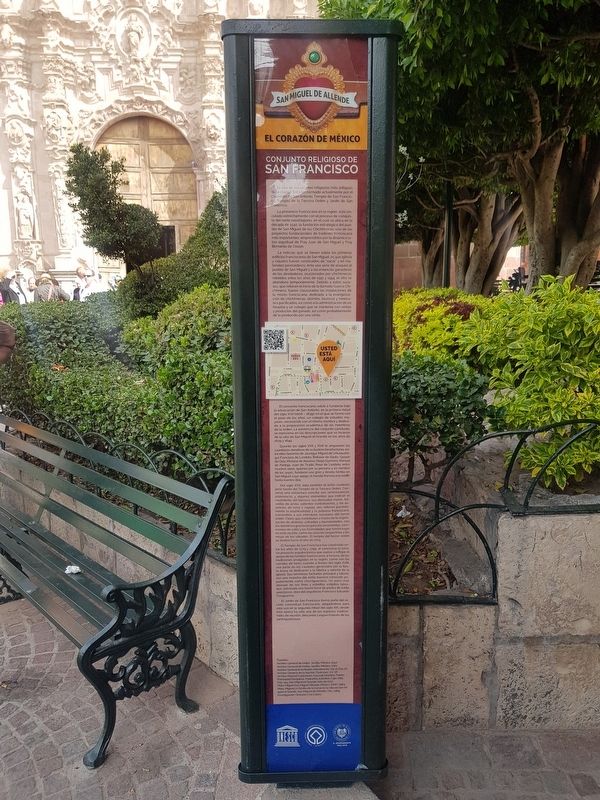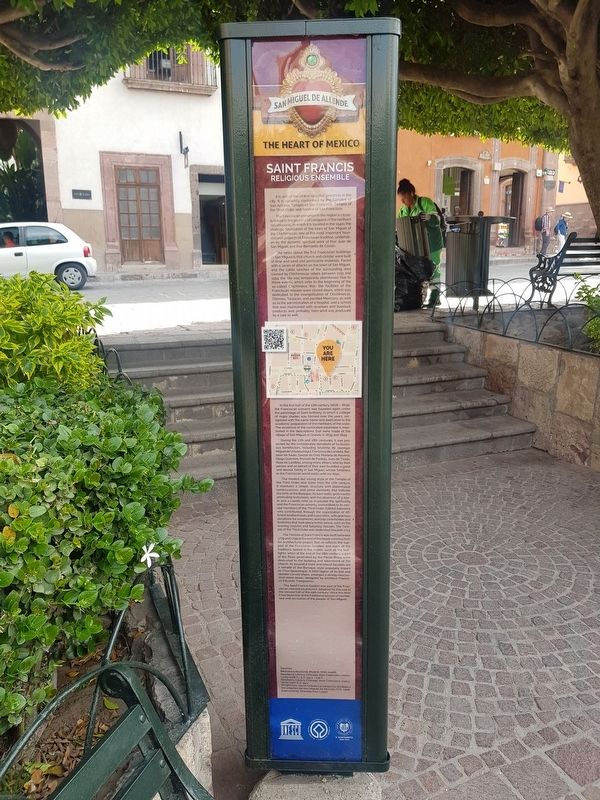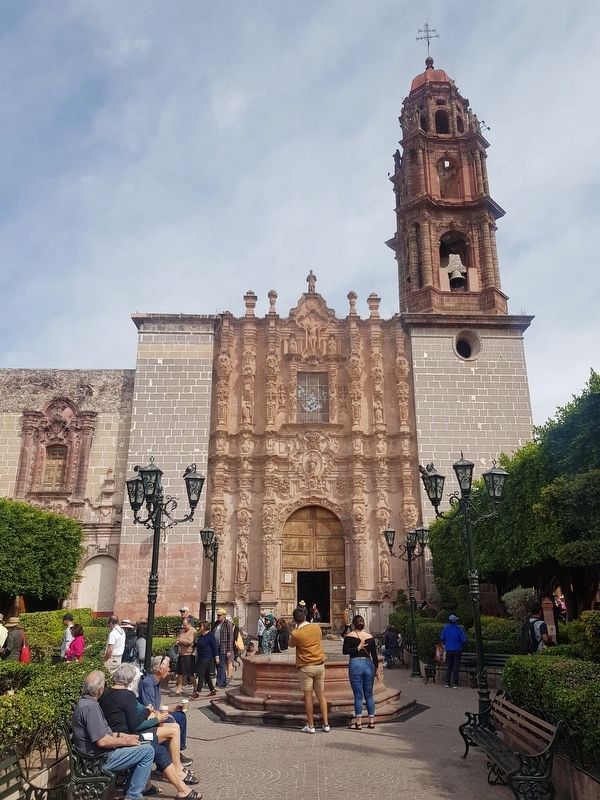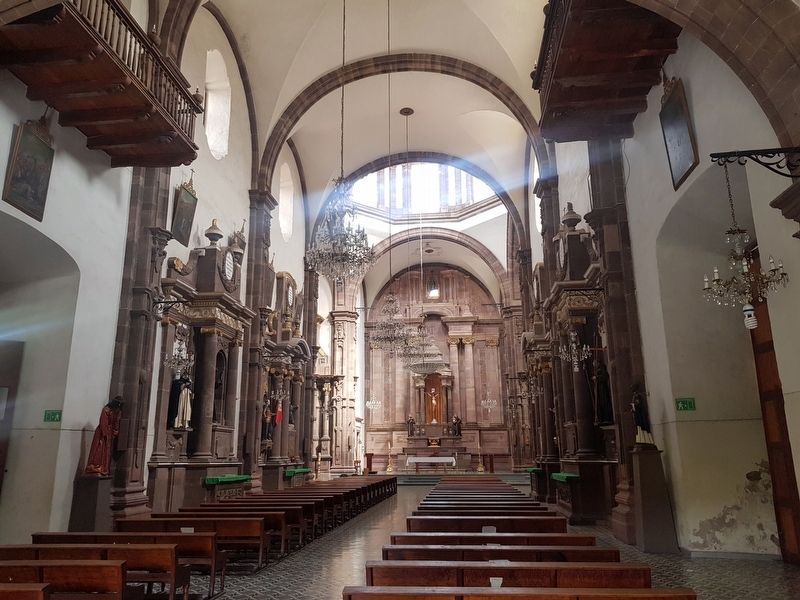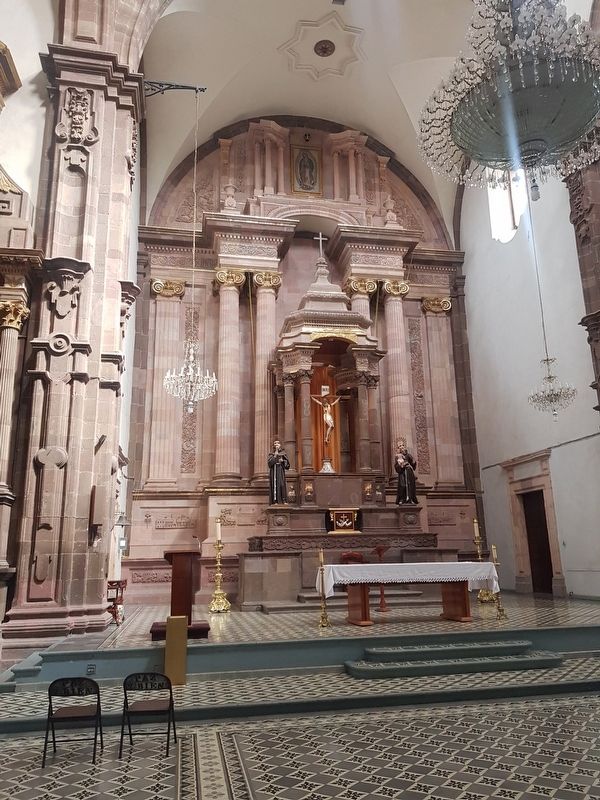San Miguel de Allende, Guanajuato, Mexico — The Central Highlands (North America)
Saint Francis Religious Ensemble
San Miguel de Allende - El Corazón de México
Es uno de los recintos religiosos más antiguos de la ciudad. Esta conformado actualmente por el Convento de San Antonio, Templo de San Francisco, Templo de la Tercera Orden y Jardín de San Francisco.
La presencia franciscana en la región, está vinculada estrechamente con el proceso de conquisa del norte novohispano, en el cual se ubica en la década de 1540, la fundación estratégica del pueblo de San Miguel de los Chichimecas; uno de los proyectos fundacionales de tradición franciscana más importantes, emprendidos por la dinámica labor espiritual de Fray Juan de San Miguel y Fray Bernardo de Cossin.
La noticias que se tienen sobre los primeros edificios franciscanos de San Miguel, es que iglesia y claustro fueron construidos de “xacal” y en materiales perecederos. Ante una serie de ataques al pueblo de San Miguel y a las estancias ganaderas de los alrededores, ocasionados por chichimecas rebeldes entre los años de 1551 y 1554, el sitio se abandonó temporalmente. Debido a estos sucesos, que refieren el inicio de la llamada Guerra Chichimeca, fueron clausuradas las instalaciones de la misión franciscana, dedicada a evangelizar de chichimecas, otomies, tarascos y mexicanos pacificados, asi como a la administración de un hospital y un colegio que se mantenía con rentas y productos del ganado, así como probablemente de los producido por una venta.
El convento franciscano volvió a fundarse bajo la advocación de San Antonio, en la primera mitad del siglo XVII (1606-1639); en el que se formó con el paso de los años, un colegio de estudios mayores, reconocido con el mismo nombre y dedicado a la preparación académica de los miembros de la orden. La existencia del conjunto concluido, se menciona en las descripciones que se hicieron de la villa de San Miguel el Grande en los años de 1639 y 1649.
Durante los siglos XVII y XVIII le ampararon los cuantiosos donativos de sus ilustres benefactores, entre ellos Severino de Jáuregui, Miguel de Urtusaustegui Francisco de Landeta, Baltasar de Sauto, Gaspar de Osio, Mariana de Alavena, Diego Guerrero, Manuel de Pantoja, Juan de Tirado, Rosa de Landeta, entre muchos otros, quienes por su persona y en nombre de los suyos, fundaron una gran y devota familia en San Miguel cuyo apego al mundo franciscano existe hasta nuestros días.
Del siglo XVII, data también el estilo modesto pero fuerte del Templo de la Tercera Orden. Conserva una estructura sencilla con reminiscencias platerescas,
y algunos elementos que indican el nacimiento del barroco, sus desnudos mudos, bóvedas de arista, salientes contrafuertes, y las ausencias de torre y cúpula, nos refieren paralelamente la espiritualidad y la pobreza franciscana, transmitida a sus miembros seculares del tercer orden. Fieles que contribuían a través de la organización de distintas cofradías y hermandades, con los
donativos graciosos para los ornamentos, ceremonias de culto y las festividades que tenían lugar en este recinto, como los rosarios verpertinos y las misas de los sábados. El templo del tercer orden se dedicó hacia el año de 1713.
El Templo de San Francisco fue construido entre los años de 1779 y 1799, al concluirse la torre. Un proyecto arquitectónico que vuelve a reflejar el apoyo de las familias franciscanas, e incluso, de las tradiciones arraigadas en la región, como son las corridas de toros; cuando a finales del siglo XVIII, una parte de los caudales generados por la fiesta brava se dedicaron a la fábrica y adorno de la iglesia. Sus hermosas fachadas principal y lateral, son una muestra del estilo barroco conocido popularmente como churrigueresco. Un poco más elevada de sus finos y esbeltos estípites labrados, sobresale una fuerte torre de piedra de estilo neoclásico, obra del arquitecto Francisco Eduardo Tresguerras.
El Jardín de San Francisco formó parte del recinto conventual franciscano,
adaptándose para este uso en la segunda mitad del siglo XIX; desde esta época ha sido uno de los espacios tradicionales de reunión, descanso y esparcimiento de los sanmiguelense.
Fuentes:
Archivo General de Indias, Sevilla; México, 1047.
Archivo General de Indias, Sevilla; México, 1061.
Archivo General de la Nación, Intendencias, Vol. 21, Exp. 20.
Archivo General de la Nación, Padrones, Vol. 36.
Archivo Manuel Castañeda, Casa de Morelos; Fondo Parroquial Disciplinar, Padrones, Asientos, Caja 1284, Exp. 149, San Miguel el Grande, Año de 1747.
Malo Miguel, San Miguel Allende, México, INAH, 1963.
Malo, Miguel, La familia de la Canal en la villa de San Miguel el Grande, San Miguel de Allende, Gto., 1969.
Investigación: Graciela Cruz López.
English:
Saint Francis Religious Ensemble
It is one of the oldest religious precincts in the city. It is currently conformed by the Convent of San Antonio, Temple of San Francisco, Temple of the Third Order and Garden of San Francisco.
The Franciscan presence in the region is closely linked to the process of conquest of the northern novohispanic, in which it is located in the 1540s the strategic foundation of the town of San Miguel of the Chichimecas; one of the most important foundational projects of Franciscan tradition, undertaken by the dynamic spiritual work
of friar Juan de San Miguel and friar Bernardo de Cossin.
The news about the first Franciscan buildings of San Miguel is that church and cloister were built of lime and sand and perishable materials. Faced with a series of attacks on the town of San Miguel, and the cattle ranches of the surrounding area caused by Chichimecas rebels between 1551 and 1554, the site was temporarily abandoned. Due to these events, which refer to the beginning of the so-called Chichimeca War, the facilities of the Franciscan mission were closed down, which was dedicated to the evangelization of Chichimecas, Otomies, Tarascan, and pacified Mexicans, as well as to the administration of a hospital, and a school that was maintained with revenues and livestock products; and, probably, from what was produced by a sale as well.
In the first half of the 17th century (1606-1639), the Franciscan convent was founded again under the patronage of Saint Anthony, in which a college of major studies was formed over the years, recognized with the same name and dedicated to the academic preparation of the members of the order. The existence of the concluded ensemble is mentioned in the descriptions that were made of the village of San Miguel el Grande in 1639 and 1649.
During the 17th and 18th centuries, it was protected by the considerable donations of its illustrious benefactors, including Severino de Jáuregui, Miguel de Urtusaustegui Francisco de Landeta, Baltasar de Sauto, Gaspar de Osio, Mariana de Alavena, Diego Guerrero, Manuel de Pantoja, Juan de Tirado, Rosa de Landeta, among many others, who by their person and on behalf of their own founded a great and devout family in San Miguel, whose fondness to the Franciscan world exists until our days.
The modest but strong style of the Temple of Third Order also dates from the 17th century. It maintains a simple structure with plateresque reminiscences, and some elements that indicate the birth of the Baroque; its bare walls, groin vaults, protruding buttresses, and the absences of a tower and a cupola refer us in parallel the spirituality and the Franciscan poverty, transmitted to its secular members of the Third Order; faithful followers who contributed, through the organization of different brotherhoods and fraternities, with gracious donations for ornaments, worship ceremonies and festivities that took place in this venue, such as the evening rosaries and Saturday masses. The Temple of the Third Order was dedicated towards 1713.
The Temple of Saint Francis was built between 1779 and 1799 at the end of the tower construction. An architectural project that re-reflects the support of the Franciscan families, and even, of the traditions rooted in the region, such as the bullfights; when at the end of the 18th
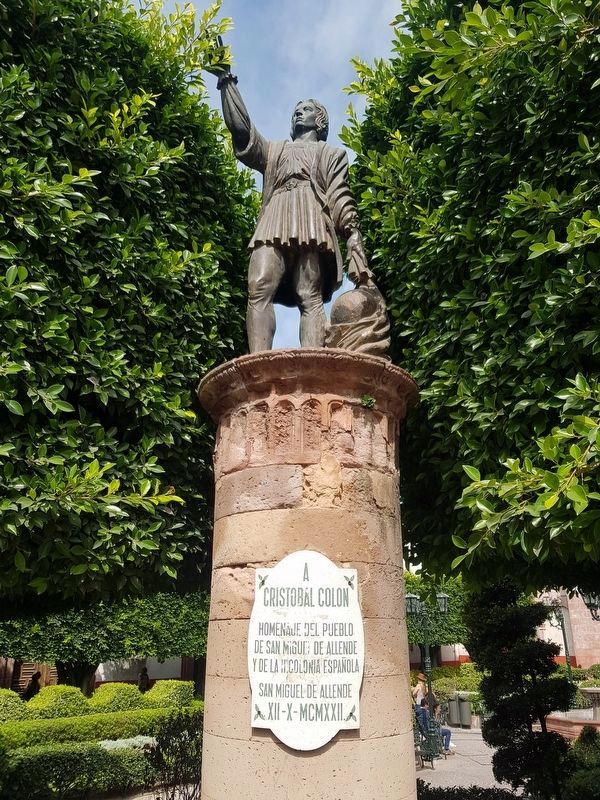
Photographed By J. Makali Bruton, February 25, 2019
6. A nearby 1922 monument to Christopher Columbus
This monument is on the southeastern corner of the temple's atrium garden. Its inscription reads:
A Cristobal Colon
Homenaje del pueblo de San Miguel de Allende y de la Il. Colonia Española
San Miguel de Allende
XII-X-MCMXXII.
English translation:
To Christoper Columbus, a tribute from the people of San Miguel de Allende and its Spanish residentes
San Miguel de Allende
October 12, 1922.
Homenaje del pueblo de San Miguel de Allende y de la Il. Colonia Española
San Miguel de Allende
XII-X-MCMXXII.
To Christoper Columbus, a tribute from the people of San Miguel de Allende and its Spanish residentes
San Miguel de Allende
October 12, 1922.
The Saint Francis Garden was part of the Franciscan conventual precinct; adapted for this use in the second half of the 19th century; since this time it has been one of the traditional spaces of reunion, rest and recreation of the people of San Miguel.
Sources:
Biblioteca Nacional, Madrid, MSS 20466.
Newberry Library, Chicago, Ayer Collection, manuscrito 1106 C.3.F 131 v-132 f.
Newberry Library, Chicago, Ayer Collection, manuscrito 1106 A, F. 44 v.
Wright, Carr, David Charles La conquista del Bajío y los orígenes de San Miguel de Allende, FCE, 1998.
Executed by: Graciela Cruz López
Erected by El Honorable Ayuntamiento de San Miguel de Allende y UNESCO.
Topics. This historical marker is listed in these topic lists: Churches & Religion • Colonial Era • Man-Made Features. A significant historical year for this entry is 1540.
Location. 20° 54.886′ N, 100° 44.523′ W. Marker is in San Miguel de Allende, Guanajuato. Marker can be reached from the intersection of San Francisco and Juárez, on the right when traveling west. Touch for map. Marker is in this post office area: San Miguel de Allende GTO 37700, Mexico. Touch for directions.
Other nearby markers. At least 8 other markers are within walking distance of this marker. The Remains of the Insurgents (a few steps from this marker); Saint Francis de Sales College (within shouting distance of this marker); Tellez Delgado Gas Pump (about 90 meters away, measured in a direct line); House of Ignacio Aldama (about 90 meters away); Site of the Primitive Post Office (about 90 meters away); Allende's Independence Meetings (about 120 meters away); House of Pedro Vargas (about 120 meters away); José María de Jesús de Diez de Sollano y Dávalos (about 120 meters away). Touch for a list and map of all markers in San Miguel de Allende.
Regarding Saint Francis Religious Ensemble. Note that for some reason, the list of sources used for the information on the marker is different in the Spanish and English texts.
Credits. This page was last revised on September 1, 2020. It was originally submitted on March 29, 2019, by J. Makali Bruton of Accra, Ghana. This page has been viewed 197 times since then and 29 times this year. Photos: 1, 2, 3, 4, 5, 6. submitted on March 29, 2019, by J. Makali Bruton of Accra, Ghana.
